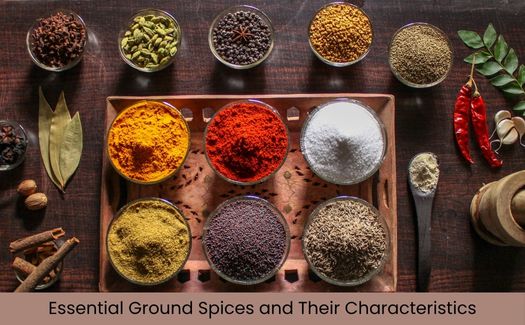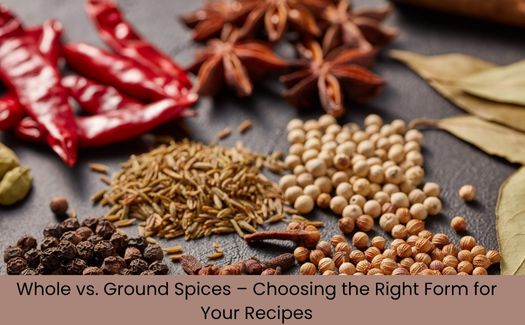Objective
The objective of this article is to explore the key differences between ground spices and whole spices, highlighting how they vary in aroma, flavor, shelf life, and culinary applications. It aims to help chefs, home cooks, and food businesses make informed decisions when choosing between the two forms for different cuisines and dishes. By the end, readers will understand how to maximize freshness, aroma, and taste by using spices correctly in everyday cooking and professional kitchens.
Introduction

Spices are the heart of global cuisine, transforming ordinary meals into aromatic masterpieces. However, one common question among cooks is — should you use whole spices or ground spices?
While both forms come from the same natural sources, their processing, storage, and cooking impact differ greatly. Choosing the right type can make a remarkable difference in flavor intensity, aroma release, and shelf stability.
Let’s explore how whole and ground spices compare — using some of the most common culinary spices like cumin, coriander, fennel, cinnamon, turmeric, and chilli — and discover when to use each for best results.
Understanding Whole Spices
Whole spices are the raw, unprocessed seeds, leaves, pods, or bark of aromatic plants. They retain their natural oils and volatile compounds, making them highly stable and long-lasting.
Common Whole Spices:
Cumin Seed, Fennel Seed, Fenugreek Seed, Coriander Seed, Dill Seed, Bishop’s Seed, Ajwain, Red Chillies, Nigella Seed (Kalonji), Bay Leaf, Turmeric, Stevia Leaves, Chilly Flakes, Cinnamon, Senna Leaves, Sesame Seeds, Senna Pods.
Key Characteristics:
- Aroma: Subtle when stored, but release a deep fragrance when toasted or ground fresh.
- Flavor: Strong and layered; develops progressively during cooking.
- Shelf Life: Long — up to 2–3 years when stored in airtight containers away from light.
- Usage: Ideal for tempering, slow cooking, pickling, and spice infusions.
Examples in Use:
- Cumin seeds release a nutty aroma when dry-roasted.
- Bay leaves add a woody depth to soups and curries.
- Cinnamon sticks infuse slow-cooked stews and desserts with warmth and sweetness.
Understanding Ground Spices
Ground spices are the powdered versions of whole spices, created through fine grinding or milling. Grinding increases surface area, allowing the flavor and aroma compounds to disperse quickly during cooking.
Common Ground Spices:
Chilli Powder, Cinnamon Powder, Clove Powder, Coriander Powder, Cumin Powder, Curry Powder, Fennel Powder, Fenugreek Powder, Garam Masala, Ginger Powder, Nutmeg Powder, Turmeric Powder.
Key Characteristics:
- Aroma: Strong and immediate — ideal for fast flavor release.
- Flavor: Bold and uniform; integrates quickly into recipes.
- Shelf Life: Shorter — typically 6–12 months, as oils oxidize faster.
- Usage: Perfect for marinades, instant mixes, sauces, and baked goods.
Examples in Use:
- Chilli powder adds heat and color to curries and snacks.
- Cumin powder enhances the earthy notes in lentils and soups.
- Turmeric powder provides color and anti-inflammatory benefits in daily cooking.
Aroma and Flavor Comparison of Whole Spices & Ground Spices
| Aspect | Whole Spices | Ground Spices |
| Aroma Release | Slow and long-lasting; it intensifies during cooking or roasting | Quick and strong; ideal for short-cook recipes |
| Flavour Intensity | Mild at first, builds over time | Immediate and concentrated |
| Oil Retention | Retains essential oils better | Loses oils faster after grinding |
| Best For | Infusing stews, rice dishes, pickles | Curries, rubs, sauces, ready-to-eat foods |
Pro Tip: To get the best of both worlds, lightly toast whole spices and grind them just before use — this technique preserves freshness and enhances aroma.
Shelf Life and Storage of Whole Spices & Ground Spices
Whole spices generally outlast their ground counterparts because their natural shell protects volatile compounds from oxidation.
- Whole Spices Shelf Life: 24–36 months
- Ground Spices Shelf Life: 6–12 months
- Storage Tips:
- Keep in airtight, opaque containers.
- Store away from direct sunlight, moisture, and heat.
- For long-term storage, buy whole and grind in small batches.
Example: Whole fennel or coriander seeds can last up to 3 years, while fennel or coriander powder should be used within 9 months for best flavor.
Culinary Applications and Usage Tips for whole spices and Ground Spices
For Whole Spices:
- Use in tempering (tadka) for Indian dishes — cumin, mustard, or ajwain seeds sizzle to release aromatic oils.
- Infuse soups, curries, or rice with bay leaves and cinnamon sticks for rich undertones.
- Roast fenugreek or fennel seeds for spice blends or digestive teas.
- Whole red chillies and sesame seeds can be used in Asian sauces and chutneys.
For Ground Spices:
- Add directly to gravies, sauces, or marinades for instant flavor.
- Mix with yogurt or oil to form spice pastes for barbecues.
- Use turmeric powder and curry powder in lentils, snacks, and stir-fries.
- Garam masala and ginger powder enhance curries and baked recipes alike.

Which One Should You Choose?
The choice between whole and ground spices depends on the cooking method, time, and desired flavor profile:
- Choose whole spices for:
- Slow-cooked dishes, pickles, and aromatic infusions
- Long shelf life and freshness retention
- Grinding your own blends like curry masala or garam masala
- Choose ground spices for:
- Quick meals, instant mixes, and uniform seasoning
- Marinades, rubs, soups, and fast-cooking snacks
- Convenience and consistent color/flavor
Balanced Approach: Many chefs use both — whole spices to infuse base flavors, and ground spices toward the end for aroma and intensity.
Practical Examples of Combined Usage of Whole Spices & Ground Spices
- Cumin: Start with whole cumin seeds for tempering, finish with cumin powder for depth.
- Coriander: Use seeds in pickling or spice blends, and coriander powder in curries.
- Cinnamon: Infuse milk or desserts with sticks, sprinkle cinnamon powder over baked treats.
- Fenugreek: Roast seeds for bitterness control, use powder in masalas for aroma balance.
Spice Export and Quality Perspective
For exporters and spice brands, offering both forms adds value to your product line.
- Whole spices appeal to traditional cooks and bulk buyers.
- Ground spices suit retail, catering, and ready-mix markets.
Ensuring purity, hygiene, and consistent grinding enhances global demand, especially in markets like the USA, Europe, Middle East, and Asia.
Conclusion
Both whole and ground spices play vital roles in cooking. Whole spices preserve freshness and aroma for long periods, while ground spices offer convenience and fast flavor. The best approach is to combine them strategically — use whole for foundation and ground for finishing.
Whether it’s the earthy warmth of cumin, the sweetness of cinnamon, or the heat of red chilli, understanding how each form behaves allows you to create more balanced, aromatic, and flavorful dishes every time.
FAQs About Whole and Ground spices
Which lasts longer, whole or ground spices?
Whole spices last 2-3 years, while ground spices typically remain fresh for up to 12 months.
Can I grind whole spices at home?
Yes. Grinding whole spices before use ensures maximum aroma and freshness. Use a spice grinder or mortar and pestle.
How can I tell if my ground spices are old?
Dull color, weak aroma, and clumping indicate loss of potency and oil oxidation.
Are whole spices healthier than ground spices?
Nutritionally both are similar, but whole spices retain essential oils longer, preserving more active compounds.
What’s the best storage method for spices?
Store in airtight containers away from moisture and sunlight. Label with purchase dates for easy freshness tracking.

